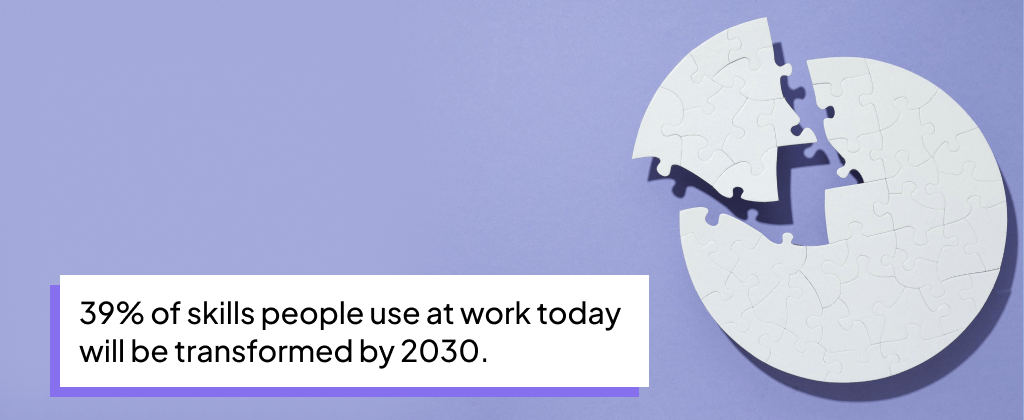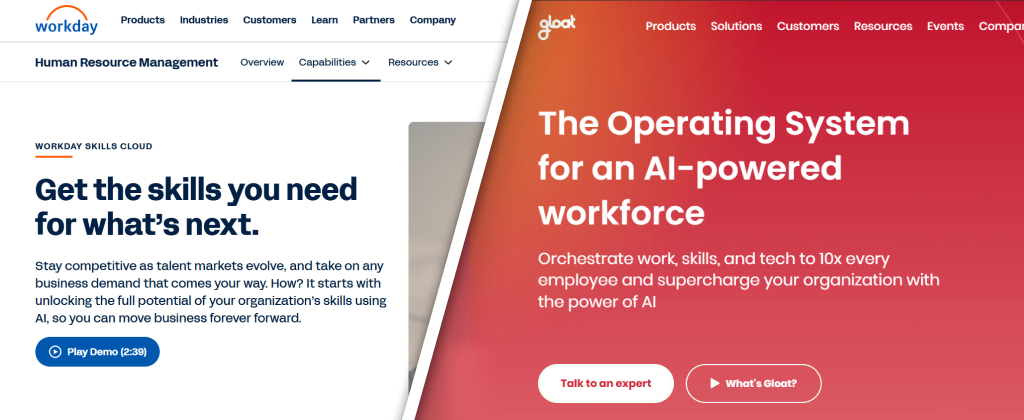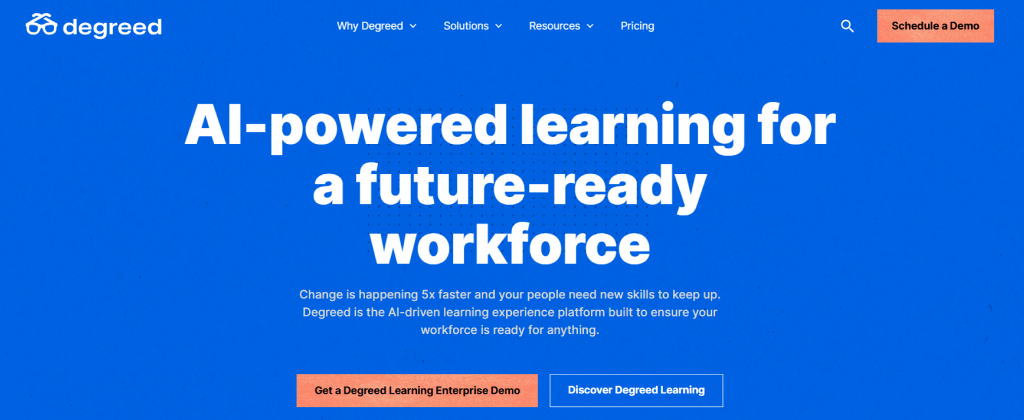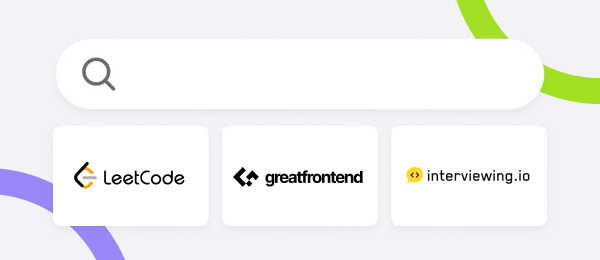Is Your Skill Gap Strategy Outdated? Here’s How AI Can Fix It
A great skill gap strategy helps organizations understand the difference between the skills their workforce has today and the ones they’ll need to meet future goals. It’s critical for effective workforce planning and strategic growth. Yet, many companies still rely on outdated methods that don’t truly reflect today’s fast-paced challenges, driven by relentless technological breakthroughs and evolving job roles. Traditional skill gap analysis techniques like static spreadsheets, self-evaluation, and annual reviews often miss the mark, leading to costly inefficiencies, misaligned strategies, and missed opportunities.
According to the World Economic Forum, 39% of skills people use at work today will be transformed or could become outdated by 2030. This alarming pace of change means that the current and future world of work is best characterized by uncertainty and continuous development. In such a rapidly evolving context, it’s no wonder skills gaps have become one of the most pressing concerns for organizations worldwide.

Despite massive investment in Learning & Development, businesses are still falling short of building teams that can thrive in the future of work. Robert Half reports that 72% of managers are concerned about addressing the skill gap at work. The issue isn’t a lack of effort – it’s often the reliance on static spreadsheets, subjective self-evaluations, and manager reviews to assess talent’s skills, legacy methods designed for a slower world.
Using outdated skill gap analysis methods results in misaligned training programs, stalled internal mobility, and a workforce that struggles to keep up with evolving demands. The root problem is clear, it’s the traditional skill gap analysis.
In this blog, we explore why it fails and how AI-driven insights are helping businesses bridge the gap with accuracy, speed, and scale.
What Does Traditional Skill Gap Analysis Look Like?
For years, organizations have approached skill gap analysis as a periodic exercise, often conducted once a year. It typically involved a manual, subjective process like:
- Self-Reported Employee Surveys: Where individuals rate their own abilities.
- Manager Performance Reviews: Often qualitative and subject to individual biases.
- Static Spreadsheets and Checklists: Rigid, manual tracking that offers limited visibility and becomes obsolete fast.
- Generic Exams Like Multiple-Choice Assessments: Testing memory more than practical application.
While these methods served a purpose in a simpler, less dynamic economy, they are manual, subjective, and designed for a slower world of work. In today’s rapidly evolving digital economy, they simply no longer cut it.
Why Traditional Skill Gap Analysis Methods Are Failing?
The disconnect between business goals and workforce capabilities often stems from inaccurate, outdated skill tracking methods. According to LinkedIn’s Workplace Learning Report, 49% of learning and talent development professionals say their executives are concerned that employees don’t have the right skills to execute business strategy.

Here are the top reasons why the traditional skill gap analysis method is falling short:
Outdated and Inaccurate: Traditional assessments like multiple-choice tests don’t reflect true skill or application – they reflect memory under pressure. These tools are designed to evaluate what employees know, not how well they can apply that knowledge in practical, job-specific scenarios. As a result, they produce surface-level insights that don’t reflect day-to-day performance or evolving role requirements. This creates a disconnect between training and real-world readiness.
Self-Reported Bias: Employees often overrate or underrate their abilities. They often overrate skills like multi-tasking, and meanwhile, crucial skills like emotional intelligence, adaptability, or conflict resolution are frequently underrated, especially in tech roles. Without standardized benchmarks, self-assessments become guesswork, leading to inaccurate skills data that HR and leadership rely on to make critical decisions.
Fragmented, Slow, & Inflexible: Traditional skill gap analysis results are obsolete by the time they’re completed. According to a WEF report, 44% of workers’ skills will need updating by 2027. Relying on static tools like spreadsheets or manual tracking leads to fragmented data and inefficient reskilling. As organizations scale, tracking capabilities across locations, roles, and levels becomes nearly impossible, making it harder to respond to change or plan strategically.
No Future-Readiness & High Cost: Traditional techniques focus on past performance rather than predicting what skills will be needed tomorrow. This backward-facing approach forces companies to hire externally rather than develop talent internally, driving up recruitment costs and longer time-to-fill. According to Accenture, G20 nations could lose $11.5 trillion in GDP over the next decade due to unaddressed skill gaps, unless new learning approaches are adopted.
The Role of AI in Skill Gap Analysis
AI is reshaping the way organizations understand and manage workforce skills. Instead of relying on static evaluations and manual inputs, AI builds dynamic, data-driven skill profiles in real time.

AI models analyze vast amounts of data across your organization, using sophisticated techniques like Natural Language Processing (NLP) to extract and categorize skills. This includes:
- Analyzing Job Performance Data: KPIs, project success metrics, feedback from collaboration tools, and peer reviews.
- Extracting Insights From Project Output: Skills demonstrated in project deliverables, team contributions, code repositories, and design documents.
- Monitoring Learning Activity: Completion rates of internal and external courses, scores on internal assessments, time spent on learning modules, types of courses taken, certifications earned, and post-session feedback via training evaluation form.
- Processing Internal Communications: Identifying skills mentioned in team chats, project management tools, and performance review comments (with appropriate privacy safeguards).
- Detecting Shifts in Job Roles and Emerging Skill Requirements: By constantly monitoring external market trends, industry reports, and internal job postings.
This allows companies to assess talent based on actual capability and demonstrated application, not just theoretical test scores or outdated feedback. The result is a continuously updated, comprehensive view of your talent landscape.
How AI Solves the Skill Gap Challenge
AI addresses the shortcomings of the traditional method, offering unparalleled accuracy, speed, and strategic foresight:
Automated & Objective Skill Mapping: AI replaces guesswork with real, objective data. Tools like Workday Skills Cloud and Gloat analyze inputs from learning platforms, work history, task completion, and team collaboration tools, they eliminate bias and build fair, consistent skill profiles across the entire organization. AI can compare employees’ competencies against industry standards, evolving job roles, and future strategic needs, helping managers visualize precisely which skills are missing and where their workforce needs improvement.

Real-Time Insights: No more waiting for annual reviews. Tools like Degreed continuously track learning engagement and skill development across organizations, showing which employees are developing new skills, which teams are under-resourced, and where to invest next. This gives HR and business leaders visibility into how employee capabilities are shifting in real-time and enables proactive decision-making and agile responses.

Predictive Workforce Planning: Tools like SkyHive not only identify current gaps but also predict which skills will be needed tomorrow. These tools leverage advanced analytics on industry trends, market shifts, technological advancements, and internal job evolution. AI provides a forward-looking approach that keeps your talent strategy ahead of the competition.

Smarter Reskilling & Internal Mobility: Instead of hiring externally, AI can reveal hidden internal talent and identify upskilling opportunities. It can suggest highly personalized learning paths tailored to the individual’s current skills, desired role, and preferred learning style. This empowers organizations to promote from within, foster career growth, and build a resilient, future-ready workforce.
Scalable Talent Intelligence: Whether you’re a 200-person startup or a global enterprise, AI scales with you. It integrates across teams, geographies, and various HR and business tools, offering a single, reliable source of truth for your organization’s workforce capabilities.
Tips & Best Practices for Using AI in Skill Gap Analysis
Adopting AI for skill gap analysis requires thoughtful implementation. Here are the best key practices:
Start with Clean Data: Before implementing AI, ensure your existing data on job roles, required competencies, and available learning resources is accurate, organized, and standardized.
Integrate Systems: Connect your Human Resources Information System (HRIS), Learning Experience Platform (LXP), Applicant Tracking System (ATS), and performance management tools. Seamless integration allows AI to analyze data holistically and provide comprehensive insights.
Make It Transparent: Ensure employees understand how their skill profiles are being generated and used. Provide access for them to view, update, and trust their skill data. Transparency fosters engagement and adoption.
Keep Business Goals in Focus: Align all reskilling and upskilling programs directly with core business strategy, not just HR KPIs. The ultimate goal is to enable the organization to achieve its strategic objectives through a well-integrated AI in business strategy that supports long-term growth and innovation.
Combine Human + AI Judgement: AI is a powerful assistant, not a replacement for human insight. Let managers validate AI-driven insights, guide development conversations, and apply their understanding of team dynamics and individual potential.
Start Small and Iterate: It’s best ot avoid implementing everything at once. Consider starting with a pilot program in a specific department or for a particular role. Learn from the initial implementation, gather feedback, and then iteratively expand your AI-driven skill analysis capabilities across the organization.
Prioritize Data Privacy and Ethics: When dealing with sensitive employee data, make sure that you have robust data privacy measures in place. Be transparent about how data is collected, stored, and used. Adhere to all relevant regulations, such as GDPR and CCPA, and establish clear ethical guidelines to build trust and prevent bias.
Final Thoughts: Adapt Now
Traditional skill gap analysis is simply too slow and too reactive for today’s dynamic world of work. It utterly fails to keep pace with the rate at which skills evolve and the complex expectations placed on modern workforces. Holding onto these outdated methods can come at a high cost, both financially and strategically.
AI provides clarity, speed, and scale, necessary to transform talent management. It empowers organizations to unlock internal talent, personalize development, and plan proactively. By embracing AI-driven skill intelligence, organizations can turn workforce planning into a competitive advantage and build teams that are agile, resilient, and future-ready.



